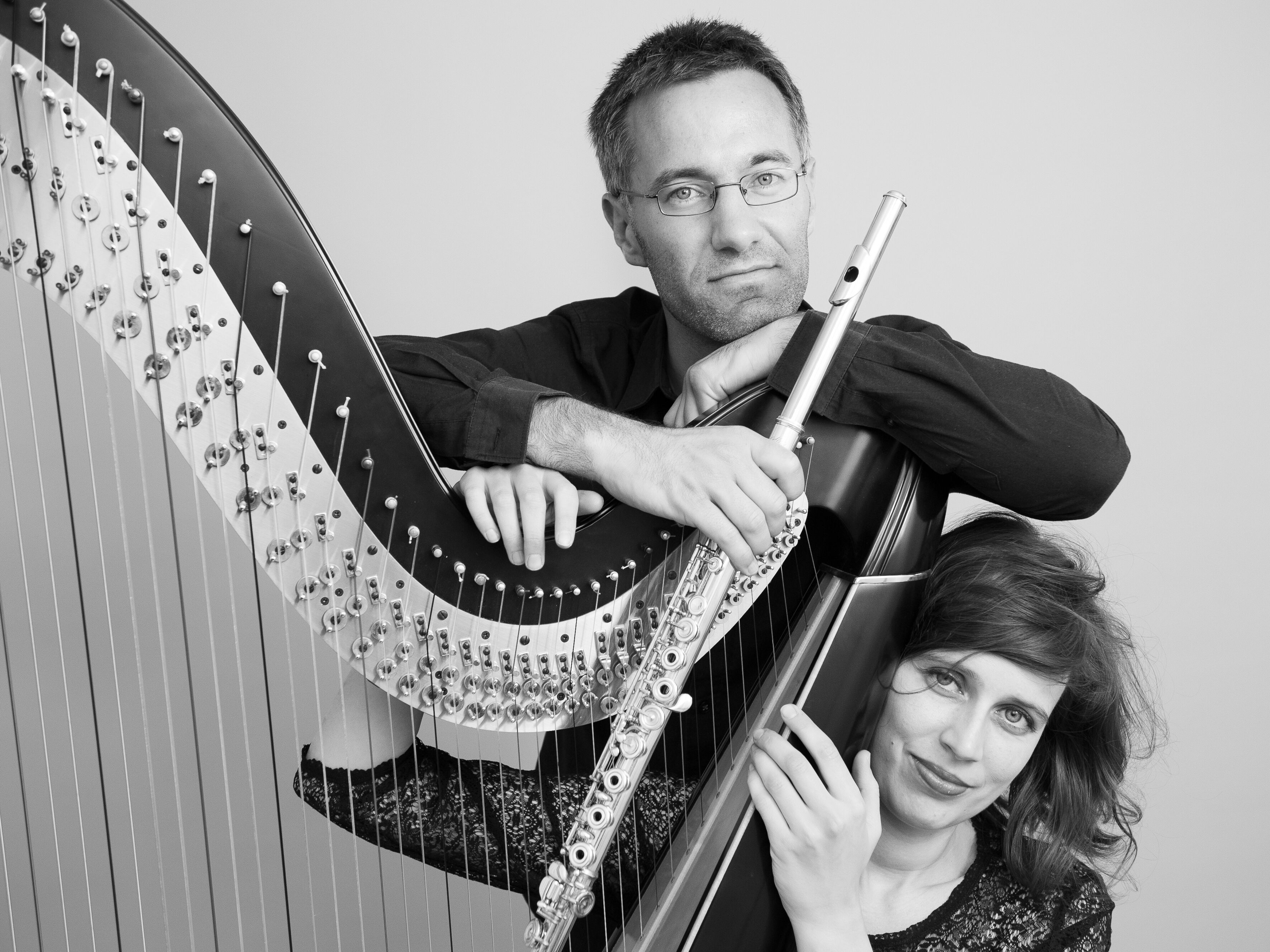DUO OXYMORON
Anna Steinkogler &
Valentin Butt
Old and new. Light and dark. Chamber music and groove. Harp and accordion. In their debut album “Scented Rushes”, the Berlin-based ensemble DUO OXYMORON creates an unconventional, colourful sound language, combining jazz, neoclassical and contemporary playing techniques.

Their love for freedom, their desire for experiments and the mix of styles both musicians can revert to results in an independent sound universe. DUO OXYMORON treats any kind of music like chamber music in the truest sense of the concept: perfect ensemble playing, careful interaction, listening, trust. Feeling the same pulse makes the groove come alive regardless of the genre.
“Scented Rushes” is a dialogue between two fairy-tale worlds, two musical languages. For our debut album, Steinkogler and Butt let themselves be inspired by three great story-tellers and philanthropists: Lewis Carroll, Maurice Ravel and Bernard Andrès. Not only their works, but also their sense of humor, earnestness and their distaste for being stuck in a pigeon hole is what attracts DUO OXYMORON to the composer Maurice Ravel and the writer and mathematician Lewis Carroll. And they both knew about the importance of blurring the lines.
“Scented Rushes” is a toungue-in-cheek homage to Lewis Carroll, author of both Alice novels. To his poetic light-heartedness. To the scented rushes always growing out of reach – “almost as if it was on purpose”.
OXYMORON — opposites attract
From the very first moment Anna Steinkogler and Valentin Butt made music together, they felt a strong musical bond, and the exciting desire to create something powerful, enthralling and intensely emotional together. The juxtaposition of their instruments — harp and accordion — has never felt like antagonisms, on the contrary, they attract each other. Their name says it all: OXYMORON.
True musicianship and dedication are the keys to Steinkogler’s and Butt’s own compelling arrangements. The contrasting personalities of both musicians and instruments seem to blend into each other on stage, while maintaining their extreme positions. Their music is an organic and refreshing take on the encounter of the well-known and the new-found.
With their own compositions, DUO OXYMORON explores and expands their aesthetics. The lack of musical traditions or role models for their uncommon instrumentation allows Anna Steinkogler and Valentin Butt to develop their own individual musical language.
“If I had a world of my own, everything would be nonsense. Nothing would be what it is because everything would be what it isn’t. And contrary wise, what is, it wouldn’t be. And what it wouldn’t be, it would. You see?” — Lewis Carroll
Repertoire (excerpt)
Anna Steinkogler, Scented Rushes (Video excerpt: I The 5th square)
Video
PANAMOUR
Anna Steinkogler &
Liam Mallett

Liam Mallett — Vita
Liam Mallett (flute), born in Whangarei (New Zealand), studied flute at the Hochschule für Musik Freiburg im Breisgau, at the Musik-Akademie Basel and at the Universität der Künste Berlin. His main interests are orchestral music, late Romanticism and contemporary music.
Since his studies Liam Mallett has been working as a freelance musician. He has worked with international orchestras such as the Gothenburg Symphony Orchestra, the Gothenburg Opera Orchestra, the Potsdam Chamber Academy, the NDR Elbphilharmonie Orchestra, the Comic Opera Orchestra, the Berlin Philharmonic Orchestra, the Camerata Bern, the Basel Symphony Orchestra and with renowned conductors like Sir Simon Rattle, Christoph Eschenbach, Neeme Järvi and Gustavo Dudamel.
As a chamber musician, soloist and lecturer he has given concerts in America, Mexico, Ukraine and many European countries. He was a member of the Academy of Komische Oper.
Repertoire (excerpt)
Bartok, Rumänische Volkstänze
Berthomieu, Cinq Nuances
Bizet, Carmen Suite
Couperin, Le Rossignol en Amour
Debussy, En Bateau
Elgar, Salut d’Amour
Fauré, Fantaisie Op. 79
Fauré, Sicilienne
Gotkovsky, Eoliènne
Ibert, Entr’acte
Jongen, Danse Lente
Marais, La Folia
Molnar, Phantasie über japanische Volkslieder
Piazzolla, Histoire du Tango
Rossini, Andante und Variationen
Rust, Sonate
Satie, Gymnopédie
Sibinga, Trois Images
Shankar, L’Aube Enchantée
Takemitsu, Towards the Sea
Videos
Audio
Harp duo
Anna Steinkogler &
Lucie Delhaye
Lucie Delhaye and Anna Steinkogler are both convinced that there is still much to be done for their beloved instrument when it comes to promoting the harp beyond well-known cliches. When performing as soloists, both performers were often struck by the audience’s surprised reaction to the harp: there is so much more to it than angelic ethereal sounds!
Repertoire, amplitude, sonority, playing techniques and colours are much more diverse than expected.
Inspired by the many questions they often have to answer after a solo recital, and the positive surprise and interest they awaken in their audience, Lucie Delhaye and Anna Steinkogler set themselves two goals when starting to work together.

On the one hand: playing chamber music at a very high level and enjoying the great possibilities of repertoire that open up when combining two harps, which is like merging two chamber orchestras into one big symphony orchestra.
Repertoire (excerpt)
G.F. Händel: Konzert in B‑Dur
Boccherini: Fandango
Schubert: Serenade / Vier Ländler
Ravel: Ma mère l’Oye
Granados: Spanischer Tanz Nr. 5
Andres: Parvis
Debussy: Clair de Lune
Debussy: Danses sacrée et profane
Video
NEWSLETTER
SAITENBLICKE — BEHIND THE SCENES
AUF der Bühne zu stehen ist fantastisch — gebündelte Energie die einen Augenblick lang sichtbar wird!
Was jedoch nicht im Scheinwerferlicht stattfindet, das WIE und WARUM, beleuchte ich in diesem Newsletter…
